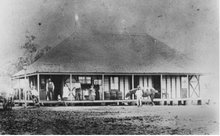Sometimes your children stump you. Blithe Girl was studying famous Australians at school (though Leichhardt like most early Australians was a migrant). She told me that Leichhardt was carrying gelatine in his supplies and that their task was to find out why. I'm not sure that the school has returned to the question but I, self-styled "Dauntless Explorer of the Internet" have.
Here's his provisions list:
"17 horses, 16 bullocks, 550 kilograms of flour, 90 kilograms of sugar, 40 kilograms of tea and 10 kilograms of gelatine."
My initial thought was that the gelatine was for photography. However, gelatin silver photography was not introduced until 1871. Instead the answer was simple and explained by the man himself.
October 18, 1844
We have regularly balanced our loads, and made up every bag of flour to the weight of 120 pounds: of these we have eight, which are to be carried by four bullocks. The chocolate and the gelatine are very acceptable at present, as so little animal food can be obtained. The country continues to be extremely boggy, though the weather has been fine, with high winds, for the last four days. Tracks of Blackfellows have been seen; but they appear rare and scattered in this part of the country. Though we meet with no game, tracks of kangaroos are very numerous, and they frequently indicate animals of great size. Emus have been seen twice.
Why would one eat gelatine? According to the Gelatin Manufacturers Institute of America, gelatin (American spelling) is 84-90% protein with 9 of the essential amino-acids. It doesn't go off though it does get sticky, it can be easily carried and though not tasty, was considered better than starving to death. Interestingly though, according to some sources, gelatine is one of the few foods that cause a nett loss of protein if eaten exclusively. There is also a link to CJD. I doubt Leichhardt was worried about any of this.
If you are interested in Australian botany, Leichhardt's journal is fascinating for his descriptions of plants especially in what is now the Scenic Rim area. Sadly he was a better botanist than navigator.
The scrub opens more and more; a beautiful country with Bricklow groves, and a white Vitex in full blossom. The flats most richly adorned by flowers of a great variety of colours: the yellow Senecios, scarlet Vetches, the large Xeranthemums, several species of Gnaphalium, white Anthemis–like compositae: the soil is a stiff clay with concretions: melon–holes with rushes; the lagoons with reeds.

No comments:
Post a Comment